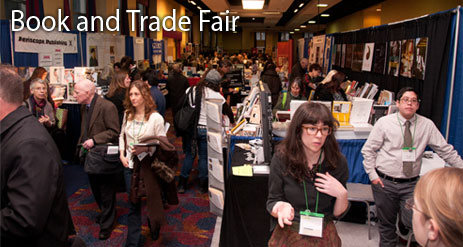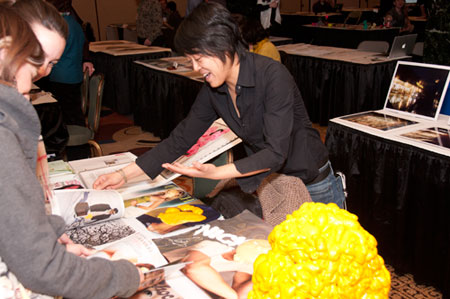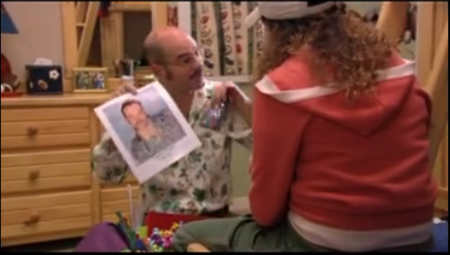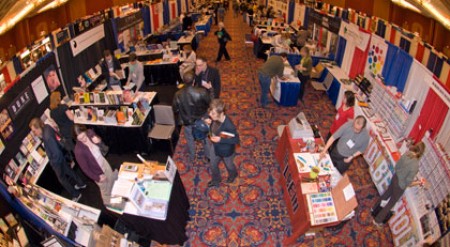
College Art Association Conference 2012 Logo. Courtesy College Art Association.
This week the College Art Association descends on Los Angeles for its annual conference and illustrious centennial celebration. The annual event brings together thousands of visual arts professionals in an unholy union of glorified job fair and academic conference. Surrounded by aesthetics, it might appear very pure and civilized, but under the surface we’re dealing with the sordid world of “networking.”
It can be easy to find yourself adrift in a sea of countless academic sessions, workshops, and interviews. But following the 2009 CAA Conference, I managed to land a part-time lecturing position (“Adjunct Pro” is actually a stretch). So listen closely, Grasshopper, as I parse my infinite CAA wisdom into some key points.

"The CAA Book and Trade Fair hosts more than 130 publishers of art books, journals and magazines, manufacturer and distributor of materials for artists, and providers of digital images and resources, among other companies and organizations." Courtesy College Art Association.
- Stakeout: While the list of activities may seem endless, skim for interesting session titles and familiar names. Chances are, the number of events that apply to your interests will be highly manageable. If you are looking for a teaching position, frequent the interview hall, even if you do not have any appointments set up ahead of time. Most institutions send at least two faculty representatives that conduct informal interviews. If you are genuinely interested in pursuing a position at a specific college or university, try to speak with every faculty member present. But save the sweet talk for quiet moments–if the table seems busy, return during one of the frequent lulls to chat with other faculty.

"ARTexchange is an annual event showcasing the art of CAA members, who can exhibit their paintings, drawings, prints, photographs, sculptures, and digital works using the space on, above, and beneath a six-foot folding table." Courtesy College Art Association.
- If you play your business cards right…you will meet and reconnect with lots of potential colleagues. Unless you’ve been burned by one too many Nigerian aristocrats, most of us look forward to receiving pleasant new emails–even if we dread writing them. Following up after the feeding frenzy can make a big difference. After the conference three years ago, I even attended some on-campus events and openings to chat with the faculty further. At the time, my friends thought I was borderline stalking, but I think it helped me land my aforementioned gig.

Tobias Fünke enlists Maeby to send out resumes and headshots, "S.O.B.s," Arrested Development, 2006. Courtesy Hulu.com.
- Don’t put all your jpegs in one basket. This one goes out to my visual artist compatriots. Put together packets with DVD/CD versions of your portfolio, your CV and even copies of your teaching philosophy, letters of reference, and student evaluations (hold the headshots and glitter). In addition, assemble an album or packet of printed photos of your work. If you simply hand over a CD of images, then your would-be colleagues may never end up seeing your art. But going through a series of video stills or printed photographs as you converse gives a face to the art. Moreover, it gives you substance for conversation, beyond the awkward first-date-like chatter that usually dominates informal interviews.

2009 College Art Association Conference. Courtesy College Art Association.
- Ballin’ on a Budget: If you have yet to come up with the cash for registration fees, check out the list of free academic sessions and career development events. In addition, you can pay-to-play with single-day or single-time slot tickets. And you only need to be a CAA member to enter the interview hall. Meanwhile, if you do register for the conference, there are plenty of ways to get your money’s worth around town. This week, about a dozen museums, including MOCA, LACMA, and the Norton Simon Museum offer free admission to CAA Conference attendees.
https://www.youtube.com/watch?v=fuZu8bBBZWo
- Gettin’ Blazered: CAA is populated primarily by curators and art historians, so the bar for looking chic-but-nerdy is woefully high. I find it especially difficult to appear professorial given that my bone structure (or lack thereof) could best be described as toddleresque, and my fashion sense (or lack thereof) is chiefly inspired by Pretty Woman pre-transformation. But after a couple rounds of CAA under my belt, I can now identify the conference dress code as thoroughly “biz cas.” Beyond that, you’re on your own.



